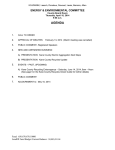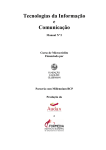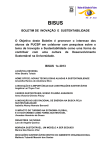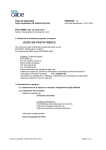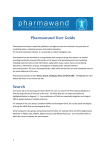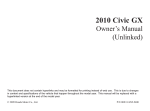Download USER GUIDE FOR CONSCIOUS CONSUMERS OF
Transcript
Itautec and sustainability USER GUIDE FOR CONSCIOUS CONSUMERS OF ELEC TRONIC PRODUC TS Looking to the future. 2 Table of Contents Who we are 3 Introduction 4 But what is sustainability really? 7 Sustainability at Itautec 9 Inside the life cycle of an equipment 10 Conscious purchase 12 Conscious use 16 Conscious post use 22 Itautec commitment to the environment 26 Glossary 27 3 Who we are We are the technology company of the Itaúsa Group, 100% Brazilian. For over 30 years, we have been developing products and solutions for data processing, banking, and retail automation, and providing technology services. We serve more than 3,700 Brazilian cities from our 34 service units and ten technical support labs. We work with leading industry forums, advocating the development of the technology sector and valuing research and development genuinely Brazilian. Our commitment to sustainability integrates, in our products, social, environmental, and economic benefits to society. Among other measures, we make rational use of natural resources and we are pioneers in manufacturing equipment free of hazardous substances and in waste recycling of IT equipment in Brazil. Because of our experience and believing in the importance of sustainability, we decided to make our contribution so that you, the consumer, know how to make best use of your electronic equipment, from the time of purchase to when you decide to discard it. We believe that disclosure of these ideas and suggestions will help encourage responsible use of technology, and contribute to environment preservation. This brings benefits not only for us, but also for future generations. 4 Introduction Imagine a world without cell phones, personal computers, flatscreen televisions, MP3, MP4, MP10 players... A world without digital cameras, video games consoles, home theater... Difficult, right? All these electronic devices are already part of our lives in such a way that we find it strange to imagine ourselves without them. However, until about 20 years ago, most of them did not exist. Those available were so expensive that few could afford them. Over time, prices fell and the electronics have become more popular. Today, it is very easy to purchase mobile phones, computers, etc. The benefits of this popularity are obvious: more people can communicate, have new options for learning, have access to more information, work better, manage their lives more comfortably, and even exert democracy that is more direct. What we often do not realize is that all these products have a story with a beginning, middle, and end, also called “life cycle”. The life cycle of an electronic product begins even before it comes to our hands. The first step is the product development project created by someone. Next, the product is made from resources extracted from nature, distributed to retail outlets where it will be marketed and, thereafter, reach consumers, who will use it perhaps for many years. After that, when the equipment is no longer useful to the consumer, it is discarded. However, the cycle does not end there. Where does the equipment go when no one else uses it? “Probably to the trash”, is our first response. Others may think that it can be recycled and used in other products, 5 minimizing the consumption of natural resources. Only then, the life cycle of the equipment will have reached the end. It is important to know that each of us, as a consumer, has a very important role in the life cycle of products and services that we use. It is exactly to help you make conscious decisions when purchasing, using, and disposing of electronics that Itautec has developed this User Guide for Conscious Consumers of Electronic Products. We have the support of Origami, a management-consulting firm specializing in sustainability, and partnership with Akatu Institute 6 for Conscious Consumption, which is renowned for its work on consumer awareness. This Guide includes the stages of purchase, use, and conscious disposal (post use) of electronic products. It has a list of simple actions that each of us can adopt in our daily lives to promote conscious consumption. It also has some suggestions of sites where you can find additional information and a glossary of some terms used in this publication. 7 But what is sustainability really? In 1987, the United Nations (UN) released a document that would change permanently the way people, businesses and governments viewed the issue of development and environment in the world. It was the report entitled “Our Common Future”¹, which drew attention, for the first time, to the risks of keeping the development model adopted by rich countries and copied by poorer nations. The warning was simple: if we continue in this model, natural resources will begin to dwindle, compromising the future generations who come after us. The report introduced the concept of “sustainable development”, according to which we must extract the natural resources and generate economic and social wealth, thinking in not only the here and now, in our immediate needs but in the tomorrow, in the future generations. But the truth is that we can see that the intense actions of humanity on the planet are producing effects that we are already feeling now. We no longer speak only of the impacts of climate change that would affect the “future generations”, for example, but of those that have already dramatically affected our lives today. More information about the report “Our Common Future” may be obtained at http://pt.wikipedia.org/wiki/Relat%C3%B3rio_Brundtland 1 8 In this context, the idea of “sustainability” is even more relevant; after all, it is now seeking a balance of human action on the economy, on society and on the environment. And this is a common challenge for all of us – individuals, businesses, governments, and organizations. In the following pages, we will see how we can act as “conscious consumers” in the purchase, use and disposal of electronic products (computers, printers, phones, refrigerators, TVs etc.). In Brazil, about 60% of the trash includes some kind of electronic waste. Much of this material ends up in landfills without any proper treatment. By the action of rain, the hazardous components that are part of electronic products eventually reach the groundwater and, consequently, about 20 million Brazilian households that lack safe water system. Water contaminated by these substances can cause many diseases that could be avoided if the electronics were recycled. 9 Sustainability at Itautec At Itautec, sustainability has long left the realm of good ideas to be incorporated into our manufacturing practices. Since 2001, we have an Environmental Management System (EMS) that includes our policies, programs, and corporate practices dedicated to socioenvironmental responsibility. This means the rational use of material, energy, and water resources, in addition to the separation of waste, promoting recycling, among other actions. But we went further in our efforts and became the first company in Brazil in the field of Information Technology to manufacture lead-free equipment. Since 2007, we manufacture PCs and notebooks free of substances harmful to the environment and human health, such as cadmium, hexavalent chromium (an anti-corrosive to protect metal parts) and bromobiphenyl (flame retardant). These materials were replaced according to the recommendations of the European RoHS directive, a world reference in restricting the use of substances that harm the environment and human health. In late 2008, other Itautec product lines also began to be manufactured in accordance with RoHS, with strict environmental controls. This required an investment of about R$ 3 million, allocated over two years for the adequacy of assembly lines. The adoption of new processes has been extended to the company’s supply chain, making many vendors adjust their inputs according to the European environmental policy. The company also pioneered the development of what is today one of the most advanced projects in electronic waste disposal in place in Brazil. It is the Recycling Center, located in Jundiaí, in São Paulo, where equipment is recycled at the end of its useful life. In this space, the equipment is received, disassembled, uncharacterized, weighed, and then have its parts separated by material type, which are sent to recyclers approved by Itautec. All our efforts in favor of sustainability have received various types of recognition, such as the 5th and 6th Brazilian Environmental Benchmarking awards and the 13th edition of FIESP Environmental Merit Award. n To learn more about the actions of Itautec for sustainability, please visit http://www.itautec.com.br/sustentabilidade or send an email to [email protected] 10 Inside the life cycle of an equipment Understanding the life cycle of an electronics product can help you make a better choice in the purchase of equipment, the extension of its use and disposal at the end of its useful life – and thus act in a way that is good for your pocket and for the environment. In the example on the next page, we show the life cycle of a notebook and present a summary of some of the impacts that each stage of this cycle may have on nature. Note that in every stage, each one of us can make an effective contribution to the sustainability of the planet. 11 3 The equipment is assembled in a manufacturing plant. 2 1 4 Natural resources are extracted and processed to be used as inputs to manufacture the notebook. LIFE CYCLE OF A NOTEBOOK A notebook is designed and developed to meet the market demands, using technology innovations appropriate for the intended audience. 6 Then comes the time to dispose of the equipment. At this moment, the consumer has two main options: 6.1.when working properly, give the notebook a new destination, reselling or donating to another user or a NGO, for example; With several other notebooks, it is send to retailers – a supermarket chain, for example – that sell directly to consumers. Or the notebook is purchased directly from the manufacturer by a large company to be use by its employees. 5 The consumer purchases the notebook, and takes it home to use for several years. 6.2.send it for recycling, thus making it part of the life cycle of other equipment, since its components will be recycled and reused. As a result, the need for extracting limited natural resources to manufacture new equipment is reduced. 12 Conscious purchase When we decide to buy new electronic equipment, we look for an option that is good, visually appealing, and affordable, that is, that has a guaranteed quality and attractive design, all for a reasonable price. But we know that nature’s resources are limited and increasingly scarce. This is forcing us to consider one more attribute at the time of purchase: sustainability. We have been increasingly valuing products and equipment that – in addition to the attributes we look for – do the least possible harm to the environment when they are manufactured, consumed, and disposed of. To manufacture products with these characteristics, companies must invest in production, distribution, sale and disposal processes that take into consideration the environmental, social, and economic consequences related to the product. The so-called “certifications” or “seals”, usually given by independent entities, are ways of giving visibility to specific efforts of companies in manufacturing equipment as friendly as possible to the environment and society. These recognitions, such as Energy Star and EPEAT, register equipment that meet certain requirements, for example, efficient use of electricity or criteria based on environmental attributes of products and business practices. The most important thing is that these labels – along with other elements, such as research on websites or chatting with other buyers - help the consumer to decide on the purchase in question. Nowadays it is increasingly easy to find information that helps the consumer make a final purchasing decision. Let’s say you want to buy, for example, a notebook. You certainly will seek products that have certain technical specifications and meet your criteria. With that, let’s say you find three or four options. This is the moment when you, as a conscious consumer, should 13 seek additional information on sustainability issues at the time of production, use and disposal of each product, i.e., its impact on the environment, society and the economy itself. This is less complicated than it seems. See below what you can do when you are deciding which product to buy: Before buying your equipment, make sure that sustainability initiatives carried out by the manufacturer are listed and explained in the product manual or in its promotional publications. Contact the manufacturers to see if they use toxic components in the manufacture of products, if they recycle equipment at the end of their useful life and how recycling is done. See also, what are the seals and certifications obtained for the equipment and the company. Visit websites that do reviews of equipment, much of its performance when used, as in the aspect of sustainability. For example, the site of the Center for the Study of Sustainability at Fundação Getulio Vargas2 has a list of products and services that best meet sustainability criteria. This catalog of products and services that meet sustainability criteria can be accessed at http://www.fgv.br/ces/cs/ Another option is the site “Good Guide”, which uses a network of experts and scientists to evaluate and compare various products from the standpoint of sustainability. Several of these products are found in Brazil. Please visit http://www.goodguide.com/ 2 14 When talking with the seller or manufacturer’s representative, also ask about the sustainability activities of the company, especially those directly applicable to the product you are looking to buy. For example, find out more about energy consumption and how can you adjust the equipment to make it more energy efficient. Ask what certifications and seals the device has and try to find information on the practical meaning of each one. Find out what you should do with your equipment when you stop using it. Does the manufacturer accept it back to recycle? If yes, how is it done? If the company is serious in its efforts to sell a sustainable product, it must have representatives that can answer questions like these. If the seller does not have an answer, he or she will most likely take this difficulty to the manufacturer. This will generate a “positive pressure” so that these professionals are properly informed. As a consumer, you are thus doing your part to encourage new behaviors. When we research and compare products, considering price, quality, and sustainability, we will have a better chance of buying a product or equipment that has these elements well balanced. With that, we send a strong message to the industry: those who do not really strive to include sustainability in their processes of manufacture, distribution, sale and disposal (“post use”), i.e., the complete life cycle of their products or services, will become increasingly outdated. Remember: a conscious consumer is always looking to make a purchase that, in addition to meeting his or her needs and desires, leaves a positive mark on the planet and society. 15 Checklist of conscious purchasing SEE HERE AN OVERVIEW OF WHAT YOU SHOULD DO BEFORE DECIDING TO PURCHASE AN EQUIPMENT Make sure you have real need to buy that product or equipment at that time. See if you can extend a little more the use of your existing equipment, making, for example, an upgrade in the case of a computer. Purchase a device that not only meets your current needs, but also can meet projected needs for the future, in order to have a long useful life. Search the Internet, talk to salespersons or with other consumers, and compare the seals and certifications of each equipment unit. Discover how each of the products you have in mind consumes energy. Be sure to choose a product from a manufacturer that is responsible for recycling when you no longer use the equipment. 16 Conscious use Okay, you bought your equipment and can now take the time to remove it from the package, install it, and start using it. If there is no problem, no fault, you can go back to your routine with new equipment that will be running for many years, whenever necessary. Oh, and do not forget, when unpacking, to dispose of the packaging material according to each type, separating the cardboard boxes from Styrofoam and plastic, for example3. If in your building, house, neighborhood, or city a selective waste collection has not yet been implemented, you will have a good chance to start a movement. Ask the City to do it, either by identifying a waste collector’s cooperative to cover your region, or by contacting the manufacturer to know its own recycling programs for packaging material. Itautec’s Recycling Center also receives packaging materials and forwards them to approved recyclers. Sometimes, the routine makes us forget that as consumers we can adopt a series of small actions that help make sustainable also how we use our equipment. Check out the following tips on how to consciously use your computer. n A 17-inch LCD monitor, when 1 Use when needed and turn it off when not in use. How many times have we left equipment on for days in a row without actually using them for all this time? Equipment units are designed to be connected and active, spends about 30 watts per hour on average. When hibernating, consumption may fall to just 1 watt per hour. Source: Sustainable Planet http://planetasustentavel. abril.com.br/noticia/energia/ conteudo_260848.shtml An interesting publication on the different ways of treating waste, including recycling at home, can be obtained from http://diariodoprofessor.com/wp-content/uploads/2008/09/cartilha.pdf 3 17 disconnected several times, so do not worry about doing this. Preferably, switch off all equipment and peripherals (modems, printers, etc.) directly into the outlet or power strip to avoid unnecessary consumption of energy by the system on standby, even when the button is off. 2 n Whenever having a break longer than half an hour, it is worth turning off the computer. A good example is at lunchtime. A computer on for one hour/day consumes 8.3 kWh per month on average. Over a year, the savings from shutting down the computer during this one-hour lunch break will be 99.3 kW/h, which makes everyone that turned off their computer stop throwing in the atmosphere 3.64 kilograms of CO2 equivalent. This volume corresponds to the one issued by a gasolinepowered car traveling 20 km. Furthermore, it results in a savings of about R$30. Source: Average energy consumption of equipment, Choice Institute - Methodology of conversion, the GHG Protocol - Aneel rates - scenery and the calculations, Itautec in-house staff. Adjust your equipment to make a rational and economical use of energy, when this option is available. Usually, equipment come with this option, which in general can be activated by the operating system installed. If you do not know how, read the equipment manual, ask the salesperson to explain how to do it or find information on the manufacturer’s website. The same goes for the monitor, which proportionally n A regular PC with a traditional CRT monitor (the one that looks consumes high energy: like a small television) consumes an average of 125.55 kW/h turn it off completely if per month. This corresponds to an emission of approximately 4.6 kilograms of CO2 equivalent (CO2e) within a month. not using the computer Therefore, within a year, this same PC emits 55.2 kg of CO2e. If this number were multiplied by about 70 million computers for an extended period used in the Brazilian market, we would conclude that Brazil or adjust the power emits approximately 3.8 million tons of CO2/year with the use of computers only. CO2 (carbon dioxide) is one of the gases settings for the device responsible for the increase in average temperature of earth. to enter sleep mode Source: Consumption, according to Choice Institute - CO2e calculation following the GHG Protocol – Scenery and when not being used for calculations, Itautec in-house staff. Note: In the process of energy conversion to CO2, the element “e” of “equivalent” is included to longer than 30 minutes. align with the principles of the GHG Protocol. 18 3 Avoid spam and do not send junk or unsolicited email. Do not participate in chain emails nor pass on emails with attachments, especially if they are heavy. Besides the possibility of a virus, these emails overwhelm the Internet system in general and make the recipient spend more time and energy by opening messages that are not relevant. 4 When replying to a message that was sent to you and other recipients, see whether your answer concerns all copied persons or only the one who sent the original message. If it only interests the sender, avoid replying to all. In doing so, you avoid overloading the system and the inboxes of people with unnecessary messages. 5 Do not print photos or documents unnecessarily. Before printing, think about whether it is really necessary or whether it is possible to read directly on the screen. If n A survey revealed that in 2009, Brazil overtook the United States in sending spam. According to data released, no less than 7.7 trillion spam messages were sent from Brazil, while the Americans sent 6.6 trillion. Yet, the company that produces McAfee antivirus estimated that the energy required just to pass the trillion spam messages sent worldwide each year is equivalent to that needed to maintain two million U.S. homes, while producing the same amount of greenhouse gas emissions of three million cars. Source: G1 Portal - http://migre.me/qSBL and “Carbon Footprint of Spam” report from McAfee that can be obtained at http://migre.me/AyR7 19 n Example of message it is necessary to print, keep an appropriate location that can be included at the bottom of your emails: to save the printed material, so that there is no need THINK AHEAD, PRESERVE to reprint it at other times, in case that you need to THE ENVIRONMENT: only print this email if you use it again. Add to the bottom of your email a short really need. text alerting the recipient to print the message only if strictly necessary. Try using also the back of the paper to print new material and recycle other printed materials that are no longer useful. 6 Facilitate the lives of people who have some visual, hearing, or motor disability. The equipment come prepared with features that let you magnify part of the screen for easier viewing. There are also technologies to convert text into speech so that the content on the screen is read aloud, and others that offer the possibility for users with limited mobility to type on the screen using a special device. 7 Is it malfunctioning? Does it seem obsolete? Before becoming enchanted by the most recent electronic novelty and decide to dispose of your equipment, ask yourself if you n The average computer uses at least cannot fix it or upgrade it. The latest ten times its weight in fossil fuels, thus computer equipment may have a lifespan contributing to energy expenditure and to global warming. It also spends 1,500 of between five and eight years with only liters of water in its manufacturing process. Proportionally, this ratio exceeds the ratio a memory upgrade after installing new for cars, for example, which use no more programs. Think that a desktop computer, than twice its weight in raw materials and inputs. A single RAM chip consumes 1.7 for example, weighs up to 25 pounds, kilograms of fossil fuels and chemicals to be manufactured, which is about 400 times and to be manufactured can use up to its weight. 60 components based on metals, plastics Source: Redemption Project 20 and other substances. All this will be lost, as well as all the energy and raw materials used, at the time that the computer is no longer being used. Several of these elements are highly contaminant to the environment and require a huge effort to be extracted from the earth and processed. Thus, the most logical is to use the equipment for as long as possible. Fonte: Recycling - From E-Waste to Resources Report - UNEP, 2010. n Be careful with the use of the Internet by your children or other children with whom you live. And if you know of any criminal action on the Internet against your children or any other children, do not think twice: report it. One tip is to visit the Safernet site, a NGO dedicated to promoting the safe use of the Internet, www.safernet.org.br, or access www.wcf.org.br to read “Navigating Safely,” featuring valuable tips to avoid online abuse and pornography. 21 Actions for a conscious use CHECK HERE A SUMMARY OF ACTIONS AND QUESTIONS TO BE MADE EVERY TIME YOU ARE ABOUT TO USE YOUR COMPUTER EQUIPMENT Have you already set up your equipment to use only the power required? Does the equipment stay on for more than 30 minutes without use? If so, turn it off. Are you going to print something? Is it really necessary? Do you already have a specific place to store your printed material? Have you already included on the bottom of your email a text reminding the recipient not to print it unless really necessary? Before disposing of equipment, consider the possibility of extending its time of use, even if you need to upgrade. Have you installed an antivirus? Tip: leave this list in a visible location, near your equipment. 22 Conscious post use “Post use” is a good term to define the moment you decide to dispose of your equipment. This is a pivotal moment in the product life cycle, since your decision on what to do with your equipment has a direct impact especially on the environment and on the economy. After all, 100% of the components of a computer, for example, are recyclable. There are several possibilities for you as a consumer to act at this moment. 1 First, the classic question: Do I really need to get rid of the equipment? Wouldn’t it be possible to invest a little to upgrade it in order to continue using it longer? 2 If you are certain that you will dispose of the equipment, you must ask if it could be useful to someone else or if it could be donated to an institution, when in working condition. This consideration should take into account the technical conditions of the equipment, i.e., if it is working well and does not need any investment to work for longer. That is because, sometimes with good intentions, we can pass along a piece of equipment that will soon present problems and will lose its usefulness to the person or institution that receives it. As we no longer have control over what will be done with the equipment, it might end up in a dump somewhere; just what we wanted to avoid from the beginning. 23 3 If you decide that the best option is to recycle the old equipment directly, some possibilities are open. The first is to contact the manufacturer of your equipment to see how you can send it for recycling. In the case of Itautec, there is a Recycling Center in Jundiai. Itautec equipment can be dropped off in any of its 34 branches. Just contact the company by sending an email to [email protected] to arrange the details of drop off. Some equipment manufacturers are committed to doing the same, so it is important to contact them for information on how to proceed. 4 The biggest problem is for those who earlier decided to buy equipment from companies that do not guarantee a proper postuse process, or that use components of dubious origin, without any warranty of compliance to Brazilian rules for environmental protection, or from manufacturers that vanished without leaving any support to consumers of their products. It is the typical situation where the cheap comes out expensive. In this case, try to find information from the Department of Environment in your city or state to know how to give an appropriate destination for your equipment. 5 In any case considering throwing your equipment in the trash. It will certainly end up in a dump, which occurs with 60% of waste in Brazil. Corrosion of parts by time and rain will 24 release hazardous components that contaminate the environment. If these components come to reach the groundwater, they will eventually contaminate our rivers and could even affect our food and our health. Consider also the thousands of people who work every day sifting through the dumps in search of articles for personal use or resale. They should not be placed on that situation of risk, in contact with various toxic elements in the electronic equipment components. Just think that the amount of electronic waste produced annually worldwide would fill all the cars of a freight train so large that it would go around the world. Each of us must do our part to reduce the scope of this impact. Source: Greenpeace - http://goo.gl/uwCL Disposal for recycling is environmentally sound and economically viable. From our experience, a computer can be 100% recyclable. Over the past three years, Itautec properly allocated some 1,700 tons of electronic waste, equivalent weight of more than 200 thousand pieces of equipment, with 97% of these materials being processed through approved recycling companies in Brazil. The remaining 3% are equivalent to the printed circuit boards, which are recycled by approved companies in Singapore and Belgium. 25 ADDITIONAL SOURCES OF INFORMATION n Itautec sustainability page http://www.itautec.com.br/sustentabilidade n Read articles and analysis on sustainability in people’s daily lives and in companies’ activities in the Origami blogs http://gestaoorigami.com.br/artigos/ n Akatu Institute for Conscious Consumption http://akatu.org.br n Redemption Project - Developed by teachers and students of Technical Computing at the Redendorista Technical School - ETER, in Campina Grande, Paraíba, aiming at educating the public on use of technologies http://redencaoeter.blogspot.com/ n Page of Greenpeace International on electronic scrap – e-waste http://www.greenpeace.org/international/campaigns/toxics n Center for Disposal and Reuse of Electronic Waste (CEDIR) at USP http://www.cce.usp.br/?q=node/266 n Safernet – NGO dedicated to promoting the safe use of Internet by children and young people. It has a space to report cybercrime. http://www.safernet.org.br 26 Itautec commitment to the environment Itautec has a reverse logistics program, that is, the commitment to receive equipment and packaging material that are unserviceable or at end of their useful life, with the goal of sending them out for recycling or recycling at the company according to the environmental standards established by the responsible agencies. Contact us for information on the Itautec collection point nearest you. n Tel: Greater Sao Paulo (11) 3543 5543 and other locations in Brazil 0800 55 0020 n Website: www.itautec.com.br n Email: [email protected] This program has existed since 2003 and now is compliant to the Federal Law 12305/10 – National Policy on Solid Waste. 27 GLOSSARY CX3 ATM Designed by Itautec in 2007, initially for the European market, it was the first banking automation equipment designed and produced in accordance to all the attributes defined by the European RoHS directive. That is, free of hazardous substances such as cadmium, mercury, hexavalent chromium, and bromobiphenyl. This project was used as a pilot for changing Itautec’s manufacturing processes and had two public recognitions for pioneering the fields of technology and environment. Source: Itautec Bromobifenilas Used as flame retardant in plastic parts of some electronic equipment, bromobiphenyl – also known as polybrominated diphenyl ethers (PBDEs) - aims to prevent the spread of flames in objects with fire risk. It is prohibited by the European RoHS directive. Equipment manufactured with PBDEs that are disposed of in the environment without adequate treatment may be harmful to our health, since over time the substance creates a dust that accumulates in the air. When you breathe this dust, you may be affected in the liver, kidneys, and even the brain, where it may cause changes in a person’s behavior. Once inside the body, the dust inhaled by the respiratory tract accumulates in adipose tissue (body fat). It is stored in the body for a long time, making babies during breastfeeding at risk if the nursing mother has inhaled the dust. For more information: http://hypescience.com/conheca-as-substancias-nocivas-mais-proximasde-voce/ and www.rohs.gov.uk Cadmium Cadmium has many industrial applications but is often used for manufacturing pigments, batteries, and plastics. It is an element found naturally in the earth’s crust and most of what is used for industrial purposes is obtained as a product of melting of rocks containing zinc, copper or lead. Like mercury, cadmium is a heavy metal that produces toxic effects on living organisms, even in very small concentrations. Some toxic effects caused by cadmium contamination on humans are: emphysema, hypertension, kidney disease, fibrosis and pulmonary edema, anemia, decreased male sex hormone (testosterone), and decreased production of antibodies, which makes a person more susceptible to other diseases. Source: http://pt.wikipedia.org For more information, please visit: www.rohs.gov.uk 28 Lead The wider use of lead is in the manufacture of batteries. Other important applications are in the manufacture of liners for wire, building construction components, pigments, soft solders, and ammunition. The manufacture of lead has been declining due to environmental regulations becoming more stringent in the world. The poisoning caused by exposure to lead can affect humans in several ways: n in the nervous system, may cause headache, muscle twitching, hallucinations, loss of memory and decreased attention span. These symptoms may progress to delirium, convulsions, paralysis and coma; n in the renal system, it causes a slow and progressive renal failure, which may become a chronic nephritis; n in the gastrointestinal system, it causes severe poisoning and may cause constipation, diarrhea and gastritis; n in the bones, lead may contribute to the development of osteoporosis in women. Children are more vulnerable than adults are to the effects of lead toxic action. Some studies have shown that lead is associated with neurobehavioral defects in children. For more information, please visit http://goo.gl/5Ci77 e http://pt.wikipedia.org/wiki/Chumbo Life cycle In the context of this Guide, it is the sequence of all stages of an electronic product, from extraction of raw materials from nature through the actual manufacturing, distribution to point of sales, customer use and final disposal, after it became useless. For more information, please visit http://planetasustentavel.abril.com.br/noticia/lixo/conteudo_391819.shtml Hexavalent chromium It is used in many industrial applications, such as stainless steel production, textile dyes, wood preservatives, leather tanning, and anticorrosive. In coatings, it is used as a corrosion inhibitor. Due to its high toxicity, it has been replaced by alternatives such as trivalent chromium, allowed by the European RoHS directive. Chromium compounds have cutaneous, nasal, bronchopulmonary, renal, gastrointestinal, and carcinogenic effects. The effects on skin are characterized by irritation at the back of hands and fingers, which may turn into ulcers. The nasal lesions begin with an inflammatory irritation, suppuration, and crust formation. At the bronchopulmonary and gastrointestinal levels, it creates bronchial irritation, respiratory function changes, and gastro duodenal ulcers. Source: http://pt.wikipedia.org/wiki/Cromo_hexavalente e http://www.mundodoquimico.hpg. ig.com.br/metais_pesados_e_seus_efeitos.htm 29 Energy Star Energy Star is a joint program of the U.S. Environmental Protection Agency (EPA) and the U.S. Department of Energy (DOE). In 1992, EPA introduced a voluntary labeling program designed to identify and promote energy-efficient products to reduce emissions of greenhouse gases from the electricity generation. Computers and monitors were the first labeled products. In 1995, the program was expanded to include labeling of office equipment products and residential heating and cooling equipment. The versions already released are increasing demands for performance and efficiency of the products that fall within the scope of the Energy Star program, with regard to efficient use of energy. Source: http://pt.wikipedia.org/wiki/Energy_Star For more information, please visit http://www.energystar.gov EPEAT It is the acronym for Electronic Product Environmental Assessment Tool, a system that serves as a reference for buyers to evaluate, compare and select electronic products (personal computers, video monitors and notebooks), according to 51 environmental attributes (23 required and 28 optional) EPEAT was created by the U.S. Environmental Protection Agency (EPA) and by the non-governmental Greener Electronics Council and establishes three categories of criteria compliance (Bronze, Silver and Gold). For the Bronze rating, all 23 required criteria must be met and for the Gold rating, it is required to meet all 23 required items plus at least 75% of the 28 optional attributes. The attributes are divided into eight categories that address the reduction/elimination of hazardous materials, materials selection, design and end-of-life management, product longevity and life cycle extension, energy conservation, corporate environmental performance, and packaging. Source: IEEE std 1680 / http://www.epeat.net/ Greenhouse gases The greenhouse gases (GHG) are gaseous substances that absorb some infrared radiation, emitted mainly by the earth’s surface, and impede this radiation to escape into space. This prevents loss of heat in excess, keeping the earth warm. The disproportionate increase in the amount of greenhouse gases in the atmosphere, however, may have a negative effect on the environment, by causing an increase in average global temperature and thereby causing climate imbalance. The major greenhouse gases are carbon dioxide (CO2), methane (CH4) and nitrous oxide (N2O). Source: Wikipedia - http://pt.wikipedia.org/wiki/Gases_do_efeito_estufa 30 GHG Protocol It is a set of measuring tools most widely used by business and governments to identify and manage greenhouse gas emissions. For more information, please visit http://www.ghgprotocolbrasil.com.br/ RoHS RoHS (Restriction of Certain Hazardous Substances) is a European directive restricting the use of certain hazardous substances in the manufacturing processes of products. Among these substances are cadmium (Cd), mercury (Hg), hexavalent chromium [Cr (VI)], polybrominated biphenyls (PBBs), polybrominated diphenyl ethers (PBDEs) and lead (Pb). This directive came into force on 1 July 2006 and, from that date on, products with these chemicals could no longer be sold in Europe. Along with the RoHS, went into force another directive addressing the recycling of electrical and electronic products, known by the acronym WEEE (Waste from Electrical and Electronic Equipment). Because of RoHS, manufacturers of electronic equipment must adapt their products to the new directive, so they can sell their products in Europe. Fonte: http://pt.wikipedia.org/wiki/Rohs For more information, please visit www.rohs.gov.uk/ Spam Spam is an unsolicited electronic message, sent in bulk, usually for advertising purposes. It can also be used to download viruses or malicious programs on the computer of the person who opens the message. Source: http://pt.wikipedia.org/wiki/Spam Twitter Twitter is an online community that brings together friends and strangers who send messages of up to 140 characters about what they are doing at the moment or any subject for which they want to draw attention. To find additional information, please visit www.twitter.com Information Technology Information Technology (IT) can be defined as the set of all activities and solutions that enable to record, communicate and obtain results from information provided by computing resources. For more information, please visit http://www.infowester.com/col150804.php 31 Itautec believes in the importance of dissemination of information and suggestions contained in this Guide. Please visit www.itautec.com.br/sustentabilidade to get a digital copy of this document. The digital version has a Creative Commons distribution license. This means you may – and should - share this text with anyone you wish, provided it is not used for commercial purposes, the source is cited or a link is included to http://www.itautec.com.br/sustentabilidade. This work may not be modified in completely or in part and its reproduction is prohibited. CREDITS MADE BY n Itautec EDITORIAL COORDINATION n Gestão Origami COLLABORATION n Akatu Institute for Conscious Consumption EDITING n Renato Guimarães / Aerton Paiva WRITING n Renato Guimarães GRAPHIC DESIGN n Arco W Comunicação & Design Copyright n Itautec 2011 This publication was developed with the key support of Origami Gestão (www.gestaoorigami.com.br), a management-consulting company with professionals highly experienced in the field of sustainability. 2ND EDITION - 08/2011 Looking to the future.
































